预计该博文篇幅较长,这里不再废话,对ganglia不太了解的去问谷老师,直接看环境:
hadoop1.updb.com 192.168.0.101
hadoop2.updb.com 192.168.0.102
hadoop3.updb.com 192.168.0.103
hadoop4.updb.com 192.168.0.104
hadoop5.updb.com 192.168.0.105
操作系统:centos 6.5 x86_64,使用自带网络yum源,同时配置epel扩展源。
在安装ganglia之前,确保你的hadoop及hbase已经安装成功,看我的安装规划:
hadoop1.updb.com NameNode|HMaster|gmetad|gmond|ganglia-web|nagios
hadoop2.updb.com DataNode|Regionserver|gmond|nrpe
hadoop3.updb.com DataNode|Regionserver|gmond|nrpe
hadoop4.updb.com DataNode|Regionserver|gmond|nrpe
hadoop5.updb.com DataNode|Regionserver|gmond|nrpe
hadoop1作为ganglia和nagios的主控端,安装的软件为ganglia的服务端gmetad、由于要监控自身节点,所以还需要安装ganglia的客户端gmond以及ganglia的web应用ganglia-web和nagios服务端;hadoop2、hadoop3、hadoop4、hadoop5作为被控端,安装的软件有ganglia的客户端gmond以及nagios的客户端nrpe。注意这里的nrpe不是一定要安装的,这里是因为我要监控hadoop2、hadoop3、hadoop4、hadoop5节点上的mysql及其他一些服务,所以选择安装nrpe。
1、hadoop1安装ganglia的gmetad、gmond及ganglia-web
首先安装ganglia所需要的依赖包
[root@hadoop1 ~]# cat ganglia.rpm apr-devel apr-util check-devel cairo-devel pango-devel libxml2-devel glib2-devel dbus-devel freetype-devel fontconfig-devel gcc-c++ expat-devel python-devel libXrender-devel zlib libart_lgpl libpng dejavu-lgc-sans-mono-fonts dejavu-sans-mono-fonts perl-ExtUtils-CBuilder perl-ExtUtils-MakeMaker [root@hadoop1 ~]# yum install -y `cat ganglia.rpm`
除了上面的依赖,还需要安装confuse-2.7.tar.gz、rrdtool-1.4.8.tar.gz两个软件
## 解压软件 [root@hadoop1 pub]# tar xf rrdtool-1.4.8.tar.gz -C /opt/soft/ [root@hadoop1 pub]# tar xf confuse-2.7.tar.gz -C /opt/soft/ ## 安装rrdtool [root@hadoop1 rrdtool-1.4.8]# ./configure -prefix=/usr/local/rrdtool [root@hadoop1 rrdtool-1.4.8]# make && make install [root@hadoop1 rrdtool-1.4.8]# mkdir /usr/local/rrdtool/lib64 [root@hadoop1 rrdtool-1.4.8]# cp /usr/local/rrdtool/lib/* /usr/local/rrdtool/lib64/ -rf [root@hadoop1 rrdtool-1.4.8]# cp /usr/local/rrdtool/lib/librrd.so /usr/lib/ [root@hadoop1 rrdtool-1.4.8]# cp /usr/local/rrdtool/lib/librrd.so /usr/lib64/ ## 安装confuse [root@hadoop1 rrdtool-1.4.8]# cd ../confuse-2.7/ [root@hadoop1 confuse-2.7]# ./configure CFLAGS=-fPIC --disable-nls --prefix=/usr/local/confuse [root@hadoop1 confuse-2.7]# make && make install [root@hadoop1 confuse-2.7]# mkdir /usr/local/confuse/lib64 [root@hadoop1 confuse-2.7]# cp /usr/local/confuse/lib/* /usr/local/confuse/lib64/ -rf
ok,准备工作做好之后,开始安装ganglia软件中的gmetad和gmond
## 解压软件 [root@hadoop1 pub]# tar xf ganglia-3.6.0.tar.gz -C /opt/soft/ [root@hadoop1 pub]# cd /opt/soft/ganglia-3.6.0/ ## 安装gmetad [root@hadoop1 ganglia-3.6.0]# ./configure --prefix=/usr/local/ganglia --with-librrd=/usr/local/rrdtool --with-libconfuse=/usr/local/confuse --with-gmetad --with-libpcre=no --enable-gexec --enable-status --sysconfdir=/etc/ganglia [root@hadoop1 ganglia-3.6.0]# make && make install [root@hadoop1 ganglia-3.6.0]# cp gmetad/gmetad.init /etc/init.d/gmetad [root@hadoop1 ganglia-3.6.0]# cp /usr/local/ganglia/sbin/gmetad /usr/sbin/ [root@hadoop1 ganglia-3.6.0]# chkconfig --add gmetad ## 安装gmond [root@hadoop1 ganglia-3.6.0]# cp gmond/gmond.init /etc/init.d/gmond [root@hadoop1 ganglia-3.6.0]# cp /usr//local/ganglia/sbin/gmond /usr/sbin/ [root@hadoop1 ganglia-3.6.0]# gmond --default_config>/etc/ganglia/gmond.conf [root@hadoop1 ganglia-3.6.0]# chkconfig --add gmond
至此,hadoop1上的gmetad、gmond安装成功,接着安装ganglia-web,首先要安装php和httpd
yum install php httpd -y
修改httpd的配置文件/etc/httpd/conf/httpd.conf,只把监听端口改为8080
Listen 8080
安装ganglia-web
[root@hadoop1 pub]# tar xf ganglia-web-3.6.2.tar.gz -C /opt/soft/ [root@hadoop1 pub]# cd /opt/soft/ [root@hadoop1 soft]# mv ganglia-web-3.6.2/ /var/www/html/ganglia [root@hadoop1 soft]# chmod 777 /var/www/html/ganglia -R [root@hadoop1 soft]# cd /var/www/html/ganglia [root@hadoop1 ganglia]# useradd www-data [root@hadoop1 ganglia]# make install [root@hadoop1 ganglia]# chmod 777 /var/lib/ganglia-web/dwoo/cache/ [root@hadoop1 ganglia]# chmod 777 /var/lib/ganglia-web/dwoo/compiled/
至此ganglia-web安装完成,修改conf_default.php修改文件,指定ganglia-web的目录及rrds的数据目录,修改如下两行:
36 # Where gmetad stores the rrd archives. 37 $conf['gmetad_root'] = "/var/www/html/ganglia"; ## 改为web程序的安装目录 38 $conf['rrds'] = "/var/lib/ganglia/rrds"; ## 指定rrd数据存放的路径
创建rrd数据存放目录并授权
[root@hadoop1 ganglia]# mkdir /var/lib/ganglia/rrds -p [root@hadoop1 ganglia]# chown nobody:nobody /var/lib/ganglia/rrds/ -R
到这里,hadoop1上的ganglia的所有安装工作就完成了,接下来就是要在hadoop2、hadoop3、hadoop4、hadoop5上安装ganglia的gmond客户端。
2、在hadoop2、hadoop3、hadoop4、hadoop5上安装gmond
首先还是需要安装依赖,参照hadoop1中的前两步来安装所需依赖
ok,准备工作做好之后,开始安装gmond,4个节点的操作是一样的,这里以hadoop2为例
## 解压软件 [root@hadoop2 pub]# tar xf ganglia-3.6.0.tar.gz -C /opt/soft/ [root@hadoop2 pub]# cd /opt/soft/ganglia-3.6.0/ ## 安装gmond,注意这里的编译和gmetad相比少了--with-gmetad [root@hadoop2 ganglia-3.6.0]# ./configure --prefix=/usr/local/ganglia --with-librrd=/usr/local/rrdtool --with-libconfuse=/usr/local/confuse --with-libpcre=no --enable-gexec --enable-status --sysconfdir=/etc/ganglia [root@hadoop2 ganglia-3.6.0]# make && make install [root@hadoop2 ganglia-3.6.0]# cp gmond/gmond.init /etc/init.d/gmond [root@hadoop2 ganglia-3.6.0]# cp /usr//local/ganglia/sbin/gmond /usr/sbin/ [root@hadoop2 ganglia-3.6.0]# gmond --default_config>/etc/ganglia/gmond.conf [root@hadoop2 ganglia-3.6.0]# chkconfig --add gmond
到这里hadoop2上的gmond已经安装成功,hadoop3、hadoop4、hadoop5依次安装成功。
3、配置ganglia,分为服务端和客户端的配置,服务端的配置文件为gmetad.conf,客户端的配置文件为gmond.conf
首先配置hadoop1上的gmetad.conf
[root@hadoop1 ~]# vi /etc/ganglia/gmetad.conf ## 定义数据源的名字及监听地址,gmond会将收集的数据发送到数据源监听机器上的rrd数据目录中 data_source "hadoop cluster" 192.168.0.101:8649
gmetad.conf的配置相当的简单,注意gmetad.conf只有hadoop1上有,因此只在hadoop1上配置。接着配置hadoop1上的gmond.conf
[root@hadoop1 ~]# head -n 80 /etc/ganglia/gmond.conf
/* This configuration is as close to 2.5.x default behavior as possible
The values closely match ./gmond/metric.h definitions in 2.5.x */
globals {
daemonize = yes ## 以守护进程运行
setuid = yes
user = nobody ## 运行gmond的用户
debug_level = 0 ## 改为1会在启动时打印debug信息
max_udp_msg_len = 1472
mute = no ## 哑巴,本节点将不会再广播任何自己收集到的数据到网络上
deaf = no ## 聋子,本节点将不再接收任何其他节点广播的数据包
allow_extra_data = yes
host_dmax = 86400 /*secs. Expires (removes from web interface) hosts in 1 day */
host_tmax = 20 /*secs */
cleanup_threshold = 300 /*secs */
gexec = no
# By default gmond will use reverse DNS resolution when displaying your hostname
# Uncommeting following value will override that value.
# override_hostname = "mywebserver.domain.com"
# If you are not using multicast this value should be set to something other than 0.
# Otherwise if you restart aggregator gmond you will get empty graphs. 60 seconds is reasonable
send_metadata_interval = 0 /*secs */
}
/*
* The cluster attributes specified will be used as part of the <CLUSTER>
* tag that will wrap all hosts collected by this instance.
*/
cluster {
name = "hadoop cluster" ## 指定集群的名字
owner = "nobody" ## 集群的所有者
latlong = "unspecified"
url = "unspecified"
}
/* The host section describes attributes of the host, like the location */
host {
location = "unspecified"
}
/* Feel free to specify as many udp_send_channels as you like. Gmond
used to only support having a single channel */
udp_send_channel {
#bind_hostname = yes # Highly recommended, soon to be default.
# This option tells gmond to use a source address
# that resolves to the machine's hostname. Without
# this, the metrics may appear to come from any
# interface and the DNS names associated with
# those IPs will be used to create the RRDs.
# mcast_join = 239.2.11.71 ## 单播模式要注释调这行
host = 192.168.0.101 ## 单播模式,指定接受数据的主机
port = 8649 ## 监听端口
ttl = 1
}
/* You can specify as many udp_recv_channels as you like as well. */
udp_recv_channel {
#mcast_join = 239.2.11.71 ## 单播模式要注释调这行
port = 8649
#bind = 239.2.11.71 ## 单播模式要注释调这行
retry_bind = true
# Size of the UDP buffer. If you are handling lots of metrics you really
# should bump it up to e.g. 10MB or even higher.
# buffer = 10485760
}
/* You can specify as many tcp_accept_channels as you like to share
an xml description of the state of the cluster */
tcp_accept_channel {
port = 8649
# If you want to gzip XML output
gzip_output = no
}
/* Channel to receive sFlow datagrams */
#udp_recv_channel {
# port = 6343
#}
/* Optional sFlow settings */好了,hadoop1上的gmetad.conf和gmond.conf配置文件已经修改完成,这时,直接将hadoop1上的gmond.conf文件scp到hadoop2、hadoop3、hadoop4、hadoop5上相同的路径下覆盖原来的gmond.conf即可。
4、启动服务
启动hadoop1、hadoop2、hadoop3、hadoop4、hadoop5上的gmond服务
/etc/init.d/gmond start
启动hadoop1上的httpd服务和gmetad服务
/etc/init.d/gmetad start /etc/init.d/httpd start
5、在浏览器中访问192.168.0.101:8080/ganglia,就会出现下面的页面
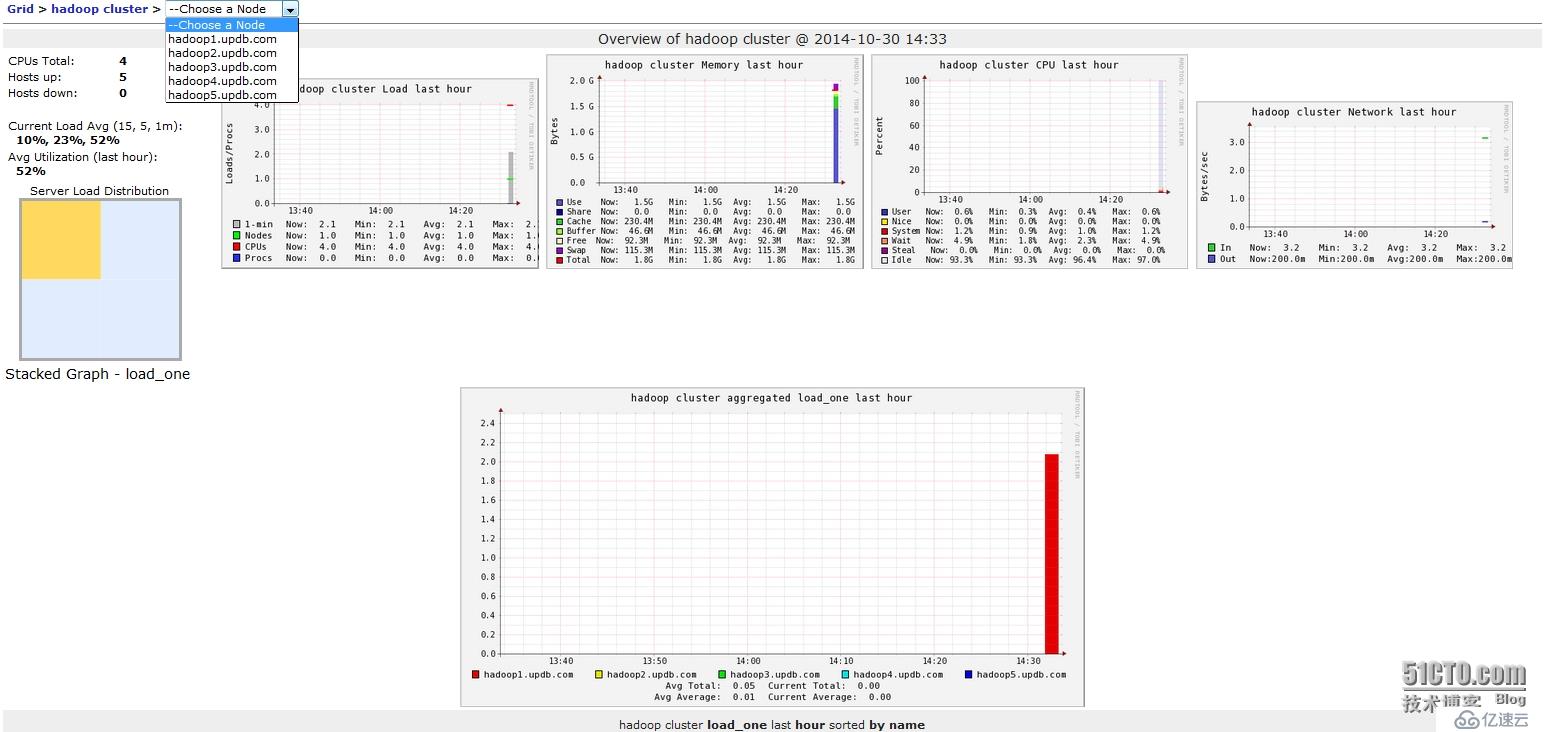
但此时,ganglia只是监控了各主机基本的性能,并没有监控到hadoop和hbase,接下来需要配置hadoop和hbase的配置文件,这里以hadoop1上的配置文件为例,其他节点对应的配置文件应从hadoop1上拷贝,首先需要修改的是hadoop配置目录下的hadoop-metrics2.properties
[root@hadoop1 ~]# cd /opt/hadoop-2.4.1/etc/hadoop/ [root@hadoop1 hadoop]# cat hadoop-metrics2.properties # # Licensed to the Apache Software Foundation (ASF) under one or more # contributor license agreements. See the NOTICE file distributed with # this work for additional information regarding copyright ownership. # The ASF licenses this file to You under the Apache License, Version 2.0 # (the "License"); you may not use this file except in compliance with # the License. You may obtain a copy of the License at # # http://www.apache.org/licenses/LICENSE-2.0 # # Unless required by applicable law or agreed to in writing, software # distributed under the License is distributed on an "AS IS" BASIS, # WITHOUT WARRANTIES OR CONDITIONS OF ANY KIND, either express or implied. # See the License for the specific language governing permissions and # limitations under the License. # # syntax: [prefix].[source|sink].[instance].[options] # See javadoc of package-info.java for org.apache.hadoop.metrics2 for details #*.sink.file.class=org.apache.hadoop.metrics2.sink.FileSink # default sampling period, in seconds #*.period=10 # The namenode-metrics.out will contain metrics from all context #namenode.sink.file.filename=namenode-metrics.out # Specifying a special sampling period for namenode: #namenode.sink.*.period=8 #datanode.sink.file.filename=datanode-metrics.out # the following example split metrics of different # context to different sinks (in this case files) #jobtracker.sink.file_jvm.context=jvm #jobtracker.sink.file_jvm.filename=jobtracker-jvm-metrics.out #jobtracker.sink.file_mapred.context=mapred #jobtracker.sink.file_mapred.filename=jobtracker-mapred-metrics.out #tasktracker.sink.file.filename=tasktracker-metrics.out #maptask.sink.file.filename=maptask-metrics.out #reducetask.sink.file.filename=reducetask-metrics.out *.sink.ganglia.class=org.apache.hadoop.metrics2.sink.ganglia.GangliaSink31 *.sink.ganglia.period=10 *.sink.ganglia.supportsparse=true *.sink.ganglia.slope=jvm.metrics.gcCount=zero,jvm.metrics.memHeapUsedM=both *.sink.ganglia.dmax=jvm.metrics.threadsBlocked=70,jvm.metrics.memHeapUsedM=40 namenode.sink.ganglia.servers=192.168.0.101:8649 datanode.sink.ganglia.servers=192.168.0.101:8649 resourcemanager.sink.ganglia.servers=192.168.0.101:8649 secondarynamenode.sink.ganglia.servers=192.168.0.101:8649 nodemanager.sink.ganglia.servers=192.168.0.101:8649
接着需要修改hbase配置目录下的hadoop-metrics2-hbase.properties
[root@hadoop1 hadoop]# cd /opt/hbase-0.98.4-hadoop2/conf/ [root@hadoop1 conf]# cat hadoop-metrics2-hbase.properties # syntax: [prefix].[source|sink].[instance].[options] # See javadoc of package-info.java for org.apache.hadoop.metrics2 for details #*.sink.file*.class=org.apache.hadoop.metrics2.sink.FileSink # default sampling period #*.period=10 # Below are some examples of sinks that could be used # to monitor different hbase daemons. # hbase.sink.file-all.class=org.apache.hadoop.metrics2.sink.FileSink # hbase.sink.file-all.filename=all.metrics # hbase.sink.file0.class=org.apache.hadoop.metrics2.sink.FileSink # hbase.sink.file0.context=hmaster # hbase.sink.file0.filename=master.metrics # hbase.sink.file1.class=org.apache.hadoop.metrics2.sink.FileSink # hbase.sink.file1.context=thrift-one # hbase.sink.file1.filename=thrift-one.metrics # hbase.sink.file2.class=org.apache.hadoop.metrics2.sink.FileSink # hbase.sink.file2.context=thrift-two # hbase.sink.file2.filename=thrift-one.metrics # hbase.sink.file3.class=org.apache.hadoop.metrics2.sink.FileSink # hbase.sink.file3.context=rest # hbase.sink.file3.filename=rest.metrics *.sink.ganglia.class=org.apache.hadoop.metrics2.sink.ganglia.GangliaSink31 *.sink.ganglia.period=10 hbase.sink.ganglia.period=10 hbase.sink.ganglia.servers=192.168.0.101:8649
将hadoop1上的这两个文件,scp到hadoop2~5这4个节点上相同的路径下,覆盖原来的文件,然后重启hadoop、hbase,这时ganglia就能够监控到hadoop和hbase了,如下如





到这里位置ganglia已经完全安装配置完成了,且已经成功的监控到了hadoop和hbase。
接下来,安装nagios,在hadoop1上安装nagios服务端、在hadoop2、hadoop3、hadoop4、hadoop5上安装客户端nrpe。
首先在hadoop1上安装nagios、及相关插件
yum install nagios nagios-plugins nagios-plugins-all nagios-plugins-nrpe -y
设置nagios web界面的登录口令
[root@hadoop1 ~]# cat /etc/httpd/conf.d/nagios.conf # SAMPLE CONFIG SNIPPETS FOR APACHE WEB SERVER # Last Modified: 11-26-2005 # # This file contains examples of entries that need # to be incorporated into your Apache web server # configuration file. Customize the paths, etc. as # needed to fit your system. ScriptAlias /nagios/cgi-bin/ "/usr/lib64/nagios/cgi-bin/" <Directory "/usr/lib64/nagios/cgi-bin/"> # SSLRequireSSL Options ExecCGI AllowOverride None Order allow,deny Allow from all # Order deny,allow # Deny from all # Allow from 127.0.0.1 ## 这里的用户名必须是nagiosadmin AuthName "nagiosadmin" AuthType Basic ## 这里指定密码文件的路径 AuthUserFile /etc/nagios/htpasswd.users Require valid-user </Directory> Alias /nagios "/usr/share/nagios/html" <Directory "/usr/share/nagios/html"> # SSLRequireSSL Options None AllowOverride None Order allow,deny Allow from all # Order deny,allow # Deny from all # Allow from 127.0.0.1 ## 这里的用户名必须是nagiosadmin AuthName "nagiosadmin" AuthType Basic ## 这里指定密码文件的路径 AuthUserFile /etc/nagios/htpasswd.users Require valid-user </Directory>
保存,退出,生成密码文件
[root@hadoop1 ~]# htpasswd -c /etc/nagios/htpasswd.users nagiosadmin New password: Re-type new password: Adding password for user nagiosadmin [root@hadoop1 ~]# cat /etc/nagios/htpasswd.users nagiosadmin:qWrXYKDlycqHM
生成密码成功,接着在hadoop2、hadoop3、hadoop4、hadoop5上安装客户端nrpe及相关插件
yum install nagios-plugins nagios-plugins-nrpe nrpe nagios-plugins-all -y
所有节点的插件均位于/usr/lib64/nagios/plugins/下
[root@hadoop2 ~]# ls /usr/lib64/nagios/plugins/ check_breeze check_game check_mrtgtraf check_overcr check_swap check_by_ssh check_hpjd check_mysql check_pgsql check_tcp check_clamd check_http check_mysql_query check_ping check_time check_cluster check_icmp check_nagios check_pop check_udp check_dhcp check_ide_smart check_nntp check_procs check_ups check_dig check_imap check_nntps check_real check_users check_disk check_ircd check_nrpe check_rpc check_wave check_disk_smb check_jabber check_nt check_sensors negate check_dns check_ldap check_ntp check_simap urlize check_dummy check_ldaps check_ntp_peer check_smtp utils.pm check_file_age check_load check_ntp.pl check_snmp utils.sh check_flexlm check_log check_ntp_time check_spop check_fping check_mailq check_nwstat check_ssh check_ftp check_mrtg check_oracle check_ssmtp
要想让nagios与ganglia整合起来,就需要在hadoop1上把ganglia安装包中的ganglia的插件放到nagios的插件目录下
[root@hadoop1 ~]# cd /opt/soft/ganglia-3.6.0/ [root@hadoop1 ganglia-3.6.0]# ls contrib/check_ganglia.py contrib/check_ganglia.py [root@hadoop1 ganglia-3.6.0]# cp contrib/check_ganglia.py /usr/lib64/nagios/plugins/
默认的check_ganglia.py 插件中只有监控项的实际值大于critical阀值的情况,这里需要增加监控项的实际值小于critical阀值的情况,即最后添加的一段代码
[root@hadoop1 plugins]# cat check_ganglia.py
#!/usr/bin/env python
import sys
import getopt
import socket
import xml.parsers.expat
class GParser:
def __init__(self, host, metric):
self.inhost =0
self.inmetric = 0
self.value = None
self.host = host
self.metric = metric
def parse(self, file):
p = xml.parsers.expat.ParserCreate()
p.StartElementHandler = parser.start_element
p.EndElementHandler = parser.end_element
p.ParseFile(file)
if self.value == None:
raise Exception('Host/value not found')
return float(self.value)
def start_element(self, name, attrs):
if name == "HOST":
if attrs["NAME"]==self.host:
self.inhost=1
elif self.inhost==1 and name == "METRIC" and attrs["NAME"]==self.metric:
self.value=attrs["VAL"]
def end_element(self, name):
if name == "HOST" and self.inhost==1:
self.inhost=0
def usage():
print """Usage: check_ganglia \
-h|--host= -m|--metric= -w|--warning= \
-c|--critical= [-s|--server=] [-p|--port=] """
sys.exit(3)
if __name__ == "__main__":
##############################################################
ganglia_host = '192.168.0.101'
ganglia_port = 8649
host = None
metric = None
warning = None
critical = None
try:
options, args = getopt.getopt(sys.argv[1:],
"h:m:w:c:s:p:",
["host=", "metric=", "warning=", "critical=", "server=", "port="],
)
except getopt.GetoptError, err:
print "check_gmond:", str(err)
usage()
sys.exit(3)
for o, a in options:
if o in ("-h", "--host"):
host = a
elif o in ("-m", "--metric"):
metric = a
elif o in ("-w", "--warning"):
warning = float(a)
elif o in ("-c", "--critical"):
critical = float(a)
elif o in ("-p", "--port"):
ganglia_port = int(a)
elif o in ("-s", "--server"):
ganglia_host = a
if critical == None or warning == None or metric == None or host == None:
usage()
sys.exit(3)
try:
s = socket.socket(socket.AF_INET, socket.SOCK_STREAM)
s.connect((ganglia_host,ganglia_port))
parser = GParser(host, metric)
value = parser.parse(s.makefile("r"))
s.close()
except Exception, err:
print "CHECKGANGLIA UNKNOWN: Error while getting value \"%s\"" % (err)
sys.exit(3)
if critical > warning:
if value >= critical:
print "CHECKGANGLIA CRITICAL: %s is %.2f" % (metric, value)
sys.exit(2)
elif value >= warning:
print "CHECKGANGLIA WARNING: %s is %.2f" % (metric, value)
sys.exit(1)
else:
print "CHECKGANGLIA OK: %s is %.2f" % (metric, value)
sys.exit(0)
else:
if critical >=value:
print "CHECKGANGLIA CRITICAL: %s is %.2f" % (metric, value)
sys.exit(2)
elif warning >=value:
print "CHECKGANGLIA WARNING: %s is %.2f" % (metric, value)
sys.exit(1)
else:
print "CHECKGANGLIA OK: %s is %.2f" % (metric, value)
sys.exit(0)配置hadoop2、hadoop3、hadoop4、hadoop5上的nrpe客户端,这里以hadoop2为例演示,其他节点直接从hadoop2上scp,然后覆盖相同路径的下的文件即可
[root@hadoop2 ~]# cat /etc/nagios/nrpe.cfg log_facility=daemon pid_file=/var/run/nrpe/nrpe.pid ## nagios的监听端口 server_port=5666 nrpe_user=nrpe nrpe_group=nrpe ## nagios服务器主机地址 allowed_hosts=192.168.0.101 dont_blame_nrpe=0 allow_bash_command_substitution=0 debug=0 command_timeout=60 connection_timeout=300 ## 监控负载 command[check_load]=/usr/lib64/nagios/plugins/check_load -w 15,10,5 -c 30,25,20 ## 当前系统用户数 command[check_users]=/usr/lib64/nagios/plugins/check_users -w 5 -c 10 ## 根分区空闲容量 command[check_sda2]=/usr/lib64/nagios/plugins/check_disk -w 20% -c 10% -p /dev/sda2 ## mysql状态 command[check_mysql]=/usr/lib64/nagios/plugins/check_mysql -H hadoop2.updb.com -P 3306 -d kora -u kora -p upbjsxt ## 主机是否存活 command[check_ping]=/usr/lib64/nagios/plugins/check_ping -H hadoop2.updb.com -w 100.0,20% -c 500.0,60% ## 当前系统的进程总数 command[check_total_procs]=/usr/lib64/nagios/plugins/check_procs -w 150 -c 200 include_dir=/etc/nrpe.d/
scp该文件到hadoop3、hadoop4、hadoop5上相同路径下覆盖源文件,注意要将文件中的主机名改为对应的主机名。
hadoop1上配置各个主机及对应的监控项,有如下配置文件
[root@hadoop1 plugins]# cd /etc/nagios/objects/ ## 每个节点对应一个host文件和一个监控项文件,如hadoop2对应的是hadoop2.cfg和service2.cfg [root@hadoop1 objects]# ls commands.cfg hadoop3.cfg localhost.cfg service3.cfg templates.cfg contacts.cfg hadoop4.cfg printer.cfg service4.cfg timeperiods.cfg hadoop1.cfg hadoop5.cfg service1.cfg service5.cfg windows.cfg hadoop2.cfg hosts.cfg service2.cfg switch.cfg
首先在commond.cfg中声明check_ganglia、check_nrpe命令,在文件最后追加如下内容
# 'check_ganglia' command definition
define command{
command_name check_ganglia
command_line $USER1$/check_ganglia.py -h $HOSTADDRESS$ -m $ARG1$ -w $ARG2$ -c $ARG3$
}
# 'check_nrpe' command definition
define command{
command_name check_nrpe
command_line $USER1$/check_nrpe -H $HOSTADDRESS$ -c $ARG1$
}然后修改templates.cfg模版配置文件,在最后追加如下内容
define service {
use generic-service
name ganglia-service1 ## 这里的配置在service1.cfg中用到
hostgroup_name hadoop1 ## 这里的配置在hadoop1.cfg中用到
service_groups ganglia-metrics1 ## 这里的配置在service1.cfg中用到
register 0
}
define service {
use generic-service
name ganglia-service2 ## 这里的配置在service2.cfg中用到
hostgroup_name hadoop2 ## 这里的配置在hadoop2.cfg中用到
service_groups ganglia-metrics2 ## 这里的配置在service2.cfg中用到
register 0
}
define service {
use generic-service
name ganglia-service3 ## 这里的配置在service3.cfg中用到
hostgroup_name hadoop3 ## 这里的配置在hadoop3.cfg中用到
service_groups ganglia-metrics3 ## 这里的配置在service3.cfg中用到
register 0
}
define service {
use generic-service
name ganglia-service4 ## 这里的配置在service4.cfg中用到
hostgroup_name hadoop4 ## 这里的配置在hadoop4.cfg中用到
service_groups ganglia-metrics4 ## 这里的配置在service4.cfg中用到
register 0
}
define service {
use generic-service
name ganglia-service5 ## 这里的配置在service5.cfg中用到
hostgroup_name hadoop5 ## 这里的配置在hadoop5.cfg中用到
service_groups ganglia-metrics5 ## 这里的配置在service5.cfg中用到
register 0
}hadoop1的配置如下,由于hadoop1是服务端,无需使用nrpe来监控自己,配置如下
## hadoop1.cfg中的监控项为常规的本机监控项,而service1.cfg中的监控项为ganglia的监控项
[root@hadoop1 objects]# cat hadoop1.cfg
define host{
use linux-server
host_name hadoop1.updb.com
alias hadoop1.updb.com
address hadoop1.updb.com
}
define hostgroup {
hostgroup_name hadoop1
alias hadoop1
members hadoop1.updb.com
}
define service{
use local-service
host_name hadoop1.updb.com
service_description PING
check_command check_ping!100,20%!500,60%
}
define service{
use local-service
host_name hadoop1.updb.com
service_description 根分区
check_command check_local_disk!20%!10%!/
# contact_groups admins
}
define service{
use local-service
host_name hadoop1.updb.com
service_description 用户数量
check_command check_local_users!20!50
}
define service{
use local-service
host_name hadoop1.updb.com
service_description 进程数
check_command check_local_procs!250!400!RSZDT
}
define service{
use local-service
host_name hadoop1.updb.com
service_description 系统负载
check_command check_local_load!5.0,4.0,3.0!10.0,6.0,4.0
}
## services.cfg
[root@hadoop1 objects]# cat service1.cfg
define servicegroup {
servicegroup_name ganglia-metrics1
alias Ganglia Metrics1
}
## 这里的check_ganglia为commonds.cfg中声明的check_ganglia命令
define service{
use ganglia-service1
service_description HMaster负载
check_command check_ganglia!master.Server.averageLoad!5!10
}
define service{
use ganglia-service1
service_description 内存空闲
check_command check_ganglia!mem_free!200!50
}
define service{
use ganglia-service1
service_description NameNode同步
check_command check_ganglia!dfs.namenode.SyncsAvgTime!10!50
}hadoop2的配置如下,需要注意使用check_nrpe插件的监控项必须要在hadoop2上的nrpe.cfg中声明
## 这里的监控项就使用了远程客户端节点上的nrpe来收集数据并周期性的发送给hadoop1的nagios server
[root@hadoop1 objects]# cat hadoop2.cfg
define host{
use linux-server
host_name hadoop2.updb.com
alias hadoop2.updb.com
address hadoop2.updb.com
}
define hostgroup {
hostgroup_name hadoop2
alias hadoop2
members hadoop2.updb.com
}
## 这里的check_nrpe为commonds.cfg中声明的check_nrpe
define service{
use local-service
host_name hadoop2.updb.com
service_description Mysql状态
check_command check_nrpe!check_mysql
}
define service{
use local-service
host_name hadoop2.updb.com
service_description PING
check_command check_nrpe!check_ping
}
define service{
use local-service
host_name hadoop2.updb.com
service_description 根分区
check_command check_nrpe!check_sda2
}
define service{
use local-service
host_name hadoop2.updb.com
service_description 用户数量
check_command check_nrpe!check_users
}
define service{
use local-service
host_name hadoop2.updb.com
service_description 进程数
check_command check_nrpe!check_total_procs
}
define service{
use local-service
host_name hadoop2.updb.com
service_description 系统负载
check_command check_nrpe!check_load
}
## 这里的监控项为ganglia的监控项使用check_ganglia插件
[root@hadoop1 objects]# cat service2.cfg
define servicegroup {
servicegroup_name ganglia-metrics2
alias Ganglia Metrics2
}
define service{
use ganglia-service2
service_description 内存空闲
check_command check_ganglia!mem_free!200!50
}
define service{
use ganglia-service2
service_description RegionServer_Get
check_command check_ganglia!regionserver.Server.Get_min!5!15
}
define service{
use ganglia-service2
service_description DateNode_Heartbeat
check_command check_ganglia!dfs.datanode.HeartbeatsAvgTime!15!40
}hadoop3、hadoop4、hadoop5的配置与hadoop2一样,除了主机名要改之外。
最后,还要将这些配置include到nagios的主配置文件中去
## 涉及修改的内容如下,其他的保持不变即可 [root@hadoop1 objects]# vi ../nagios.cfg # You can specify individual object config files as shown below: #cfg_file=/etc/nagios/objects/localhost.cfg cfg_file=/etc/nagios/objects/commands.cfg cfg_file=/etc/nagios/objects/contacts.cfg cfg_file=/etc/nagios/objects/timeperiods.cfg cfg_file=/etc/nagios/objects/templates.cfg ## 将host文件引入进来 cfg_file=/etc/nagios/objects/hadoop1.cfg cfg_file=/etc/nagios/objects/hadoop2.cfg cfg_file=/etc/nagios/objects/hadoop3.cfg cfg_file=/etc/nagios/objects/hadoop4.cfg cfg_file=/etc/nagios/objects/hadoop5.cfg ## 将监控项的文件引入进来 cfg_file=/etc/nagios/objects/service1.cfg cfg_file=/etc/nagios/objects/service2.cfg cfg_file=/etc/nagios/objects/service3.cfg cfg_file=/etc/nagios/objects/service4.cfg cfg_file=/etc/nagios/objects/service5.cfg
接下来验证,配置项是否正确
[root@hadoop1 objects]# nagios -v ../nagios.cfg Nagios Core 3.5.1 Copyright (c) 2009-2011 Nagios Core Development Team and Community Contributors Copyright (c) 1999-2009 Ethan Galstad Last Modified: 08-30-2013 License: GPL Website: http://www.nagios.org Reading configuration data... Read main config file okay... Processing object config file '/etc/nagios/objects/commands.cfg'... Processing object config file '/etc/nagios/objects/contacts.cfg'... Processing object config file '/etc/nagios/objects/timeperiods.cfg'... Processing object config file '/etc/nagios/objects/templates.cfg'... Processing object config file '/etc/nagios/objects/hadoop1.cfg'... Processing object config file '/etc/nagios/objects/hadoop2.cfg'... Processing object config file '/etc/nagios/objects/hadoop3.cfg'... Processing object config file '/etc/nagios/objects/hadoop4.cfg'... Processing object config file '/etc/nagios/objects/hadoop5.cfg'... Processing object config file '/etc/nagios/objects/service1.cfg'... Processing object config file '/etc/nagios/objects/service2.cfg'... Processing object config file '/etc/nagios/objects/service3.cfg'... Processing object config file '/etc/nagios/objects/service4.cfg'... Processing object config file '/etc/nagios/objects/service5.cfg'... Processing object config directory '/etc/nagios/conf.d'... Read object config files okay... Running pre-flight check on configuration data... Checking services... Checked 44 services. Checking hosts... Checked 5 hosts. Checking host groups... Checked 5 host groups. Checking service groups... Checked 5 service groups. Checking contacts... Checked 1 contacts. Checking contact groups... Checked 1 contact groups. Checking service escalations... Checked 0 service escalations. Checking service dependencies... Checked 0 service dependencies. Checking host escalations... Checked 0 host escalations. Checking host dependencies... Checked 0 host dependencies. Checking commands... Checked 26 commands. Checking time periods... Checked 5 time periods. Checking for circular paths between hosts... Checking for circular host and service dependencies... Checking global event handlers... Checking obsessive compulsive processor commands... Checking misc settings... Total Warnings: 0 Total Errors: 0 Things look okay - No serious problems were detected during the pre-flight check
ok,没有错误,这时就可以启动hadoop1上的nagios服务
[root@hadoop1 objects]# /etc/init.d/nagios start Starting nagios: done.
启动hadoop2-5上的nrpe服务
[root@hadoop2 ~]# /etc/init.d/nrpe start Starting nrpe: [ OK ]
在hadoop1上测试nagios与nrpe通信是否正常
[root@hadoop1 objects]# cd /usr/lib64/nagios/plugins/ [root@hadoop1 plugins]# ./check_nrpe -H hadoop1.updb.com [root@hadoop1 plugins]# ./check_nrpe -H hadoop2.updb.com NRPE v2.15 [root@hadoop1 plugins]# ./check_nrpe -H hadoop3.updb.com NRPE v2.15 [root@hadoop1 plugins]# ./check_nrpe -H hadoop4.updb.com NRPE v2.15 [root@hadoop1 plugins]# ./check_nrpe -H hadoop5.updb.com NRPE v2.15
ok,通信正常,验证check_ganglia.py插件是否工作正常
[root@hadoop1 ~]# cd /usr/lib64/nagios/plugins/ [root@hadoop1 plugins]# ./check_ganglia.py -h hadoop2.updb.com -m mem_free -w 200 -c 50 CHECKGANGLIA OK: mem_free is 72336.00
工作正常,现在我们可以nagios的web页面,看是否监控成功。
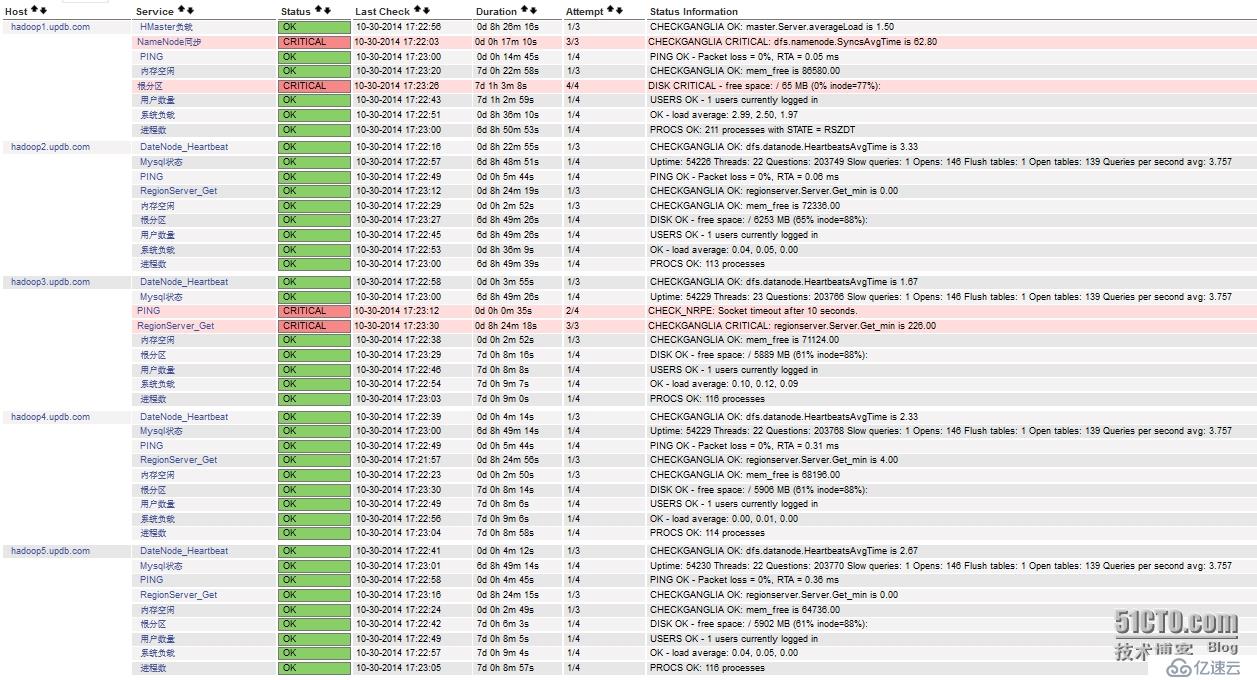
可以看到已经成功监控,如果需要监控hadoop、hbase更多更加详细的监控项,可以在这里查找,nagios中配置监控项的名字和这里出现的一致即可

你会发现,ganglia中出现的可监控项非常的多,只要你愿意,你可以监控任何你想要监控的集群选项,前提是要弄明白这些监控项的含义,以及阀值设置为多少最为合适,显然这才是真正的挑战,实验中的集群监控项我是随便选取的,并没有特别的含义,因为鄙人也还是屌丝一枚,正在慢慢学习这些监控项,好了,到这里nagios已经成功监控到了我们想要监控的内容了,那么怎么实现手机短信报警呢?
看下面,首先我们要配置contacts.cfg,添加邮件的接受人
[root@hadoop1 plugins]# cd /etc/nagios/objects/
[root@hadoop1 objects]# cat contacts.cfg
define contact{
contact_name nagiosadmin
use generic-contact
alias Nagios Admin
## 告警时间段
service_notification_period 24x7
host_notification_period 24x7
## 告警信息格式
service_notification_options w,u,c,r,f,s
host_notification_options d,u,r,f,s
## 告警方式为邮件
service_notification_commands notify-service-by-email
host_notification_commands notify-host-by-email
## 联系人的139邮箱
email 1820280----@139.com
}
## 定义联系人所属组
define contactgroup{
contactgroup_name admins
alias Nagios Administrators
members nagiosadmin
}重启nagios服务,要保证你的139邮箱开启了长短信转发格式,确保邮件到达邮箱后会转发到你的手机,这里上一张手机接受到邮件后的截图:
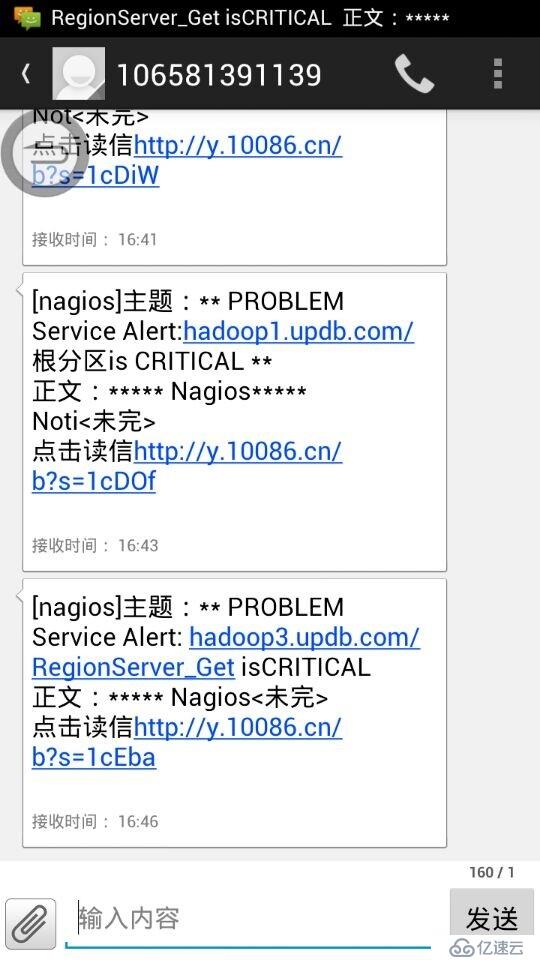
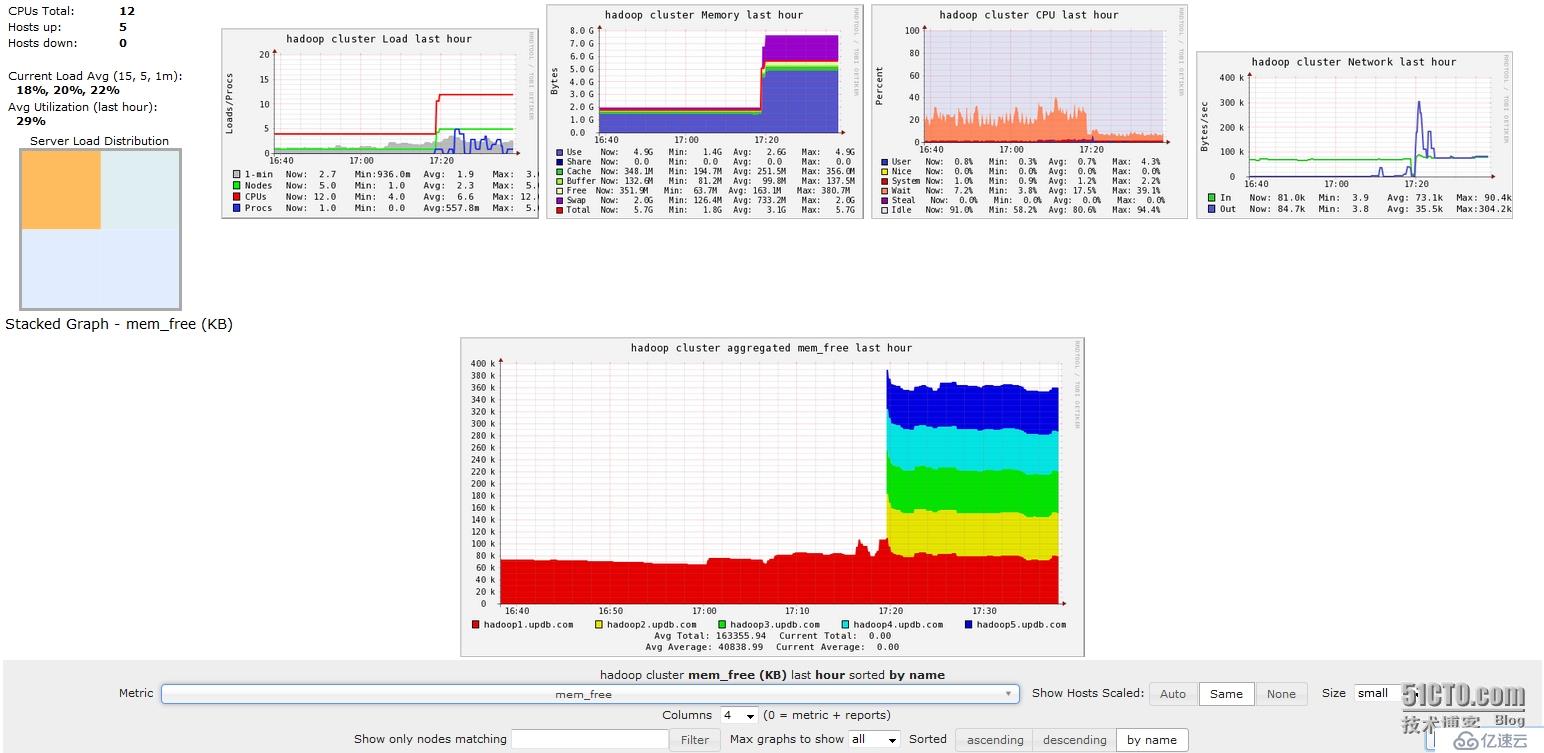
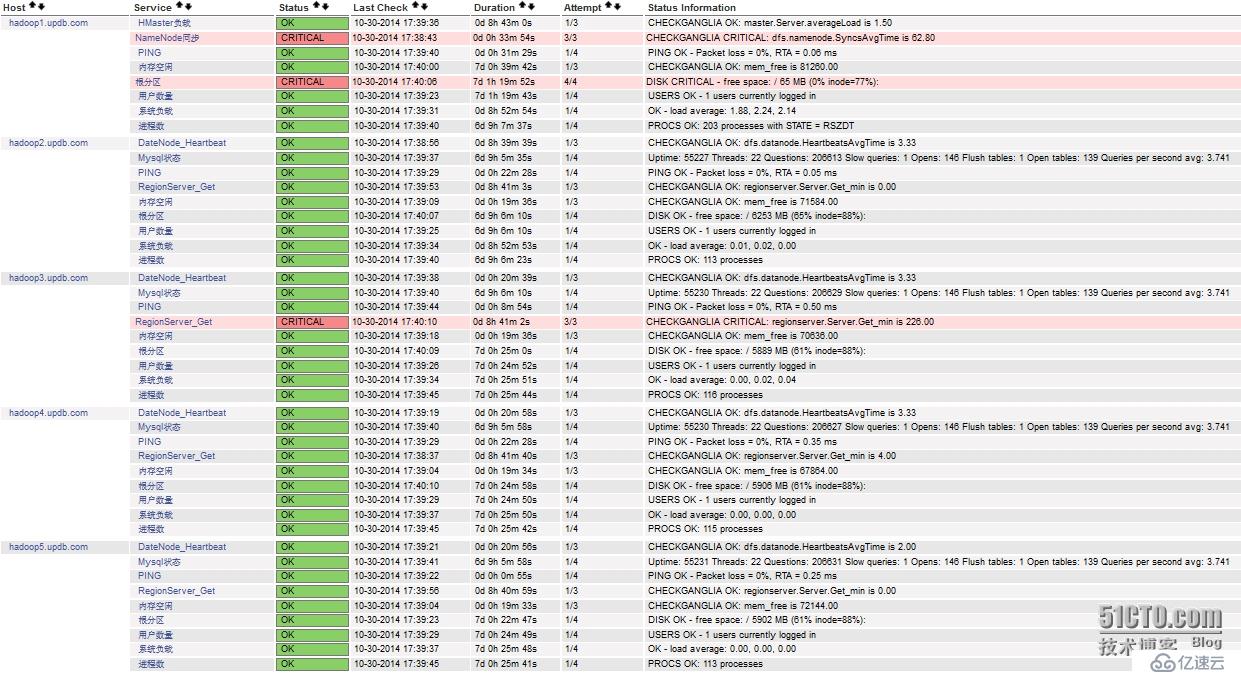
好了,大功告成。看到此刻的你,是否犹如孙悟空的精魂刚刚回归肉体,与周围的世界有片刻的神离。哈哈,好好学习ganglia的监控项,以后嘛嘛就再也不用担心你的运维工作了,上班时间就是喝茶看新闻了,坐等短信告诉你哪个地方有问题。
免责声明:本站发布的内容(图片、视频和文字)以原创、转载和分享为主,文章观点不代表本网站立场,如果涉及侵权请联系站长邮箱:is@yisu.com进行举报,并提供相关证据,一经查实,将立刻删除涉嫌侵权内容。